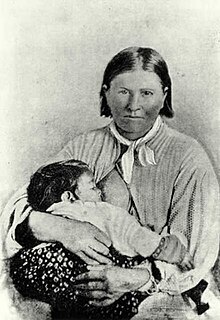Cynthia Parker
| Cynthia Ann Parker | |
|---|---|

Cynthia Ann Parker and her daughter, Topʉsana (Prairie Flower), in 1861
|
|
| Native name | Naduah (Narua) |
| Born |
c. 1825 Crawford County, Illinois |
| Disappeared | May 19, 1836 Fort Parker, Texas |
| Status | Relocated during the Battle of Pease River on December 18, 1860 |
| Died | March 1871 Anderson County, Texas |
| Cause of death | Influenza |
| Resting place | Fort Sill Post Cemetery 34°40′10″N 98°23′43″W / 34.669466°N 98.395341°W |
| Known for |
|
| Spouse(s) | Peta Nocona |
| Children |
|
| Parent(s) | Silas M. Parker and Lucy Duty |
| Relatives | Daniel Parker, John Richard Parker |
Cynthia Ann Parker, or Naduah (Comanche Narua) (c. 1825 – March 1871) was an Anglo-American who was kidnapped in 1836, at the age of about ten (possibly as young as 8 or already over 11 – her birth year is uncertain), by a Comanche war band, who had massacred her family's settlement. Her Comanche name means "someone found." She was adopted by the Comanche and lived with them for 24 years, completely forgetting her white ways. She married a Comanche chieftain, Peta Nocona, and had three children with him, including the last free Comanche chief, Quanah Parker. At approximately age 34, she was relocated by the Texas Rangers, but spent the remaining ten years of her life refusing to adjust to life in white society. At least once, she escaped and tried to return to her Comanche family and children, but was again brought back to Texas. She found it difficult to understand her iconic status to the nation, which saw her as having been redeemed from the Comanches. Heartbroken over the loss of her family, she stopped eating and died of influenza in 1871.
Cynthia was born to Silas M. Parker and Lucy Parker (née Duty) in Crawford County, Illinois. Her birth date is uncertain; according to the 1870 census of Anderson County, Texas, she was born in 1824 or 1825. Her middle name is also uncertain. Originally, it was Ana, but over the years, her name was changed to Ann. When she was nine or ten years old, her grandfather, John Parker, was recruited to settle his family in north-central Texas; he was to establish a settlement fortified against Comanche raids, which had been devastating to the Euro-American colonization of Texas and northern Mexico. The Parker family, its extended kin, and surrounding families established fortified blockhouses and a central citadel—later called Fort Parker—on the headwaters of the Navasota River in what is now Limestone County.
...
Wikipedia
